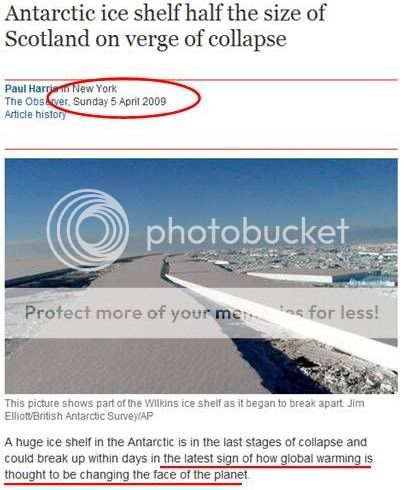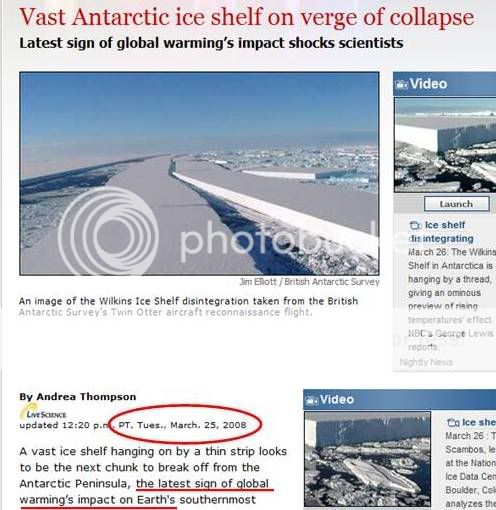Not everyone agrees.
 Handout photo released in 2008 by the British Antarctic Survey shows of a chunk of ice that started to break away from the Antarctic Wilkins Ice Shelf. A huge iceshelf that has wrenched away from the Antarctic peninsula has started to fracture into icebergs, the European Space Agency (ESA) has said.
Photograph by: AFP, Jim Elliott
Handout photo released in 2008 by the British Antarctic Survey shows of a chunk of ice that started to break away from the Antarctic Wilkins Ice Shelf. A huge iceshelf that has wrenched away from the Antarctic peninsula has started to fracture into icebergs, the European Space Agency (ESA) has said.
Photograph by: AFP, Jim Elliott
TROMSOE, Norway – An area of an Antarctic ice shelf almost the size of New York City has broken into icebergs this month after the collapse of an ice bridge widely blamed on global warming, a scientist said Tuesday.
"The northern ice front of the Wilkins Ice Shelf has become unstable and the first icebergs have been released," Angelika Humbert, glaciologist at the University of Muenster in Germany, said of European Space Agency satellite images of the shelf.
Humbert told Reuters about 700 sq km (270.3 sq mile) of ice -- bigger than Singapore or Bahrain and almost the size of New York City -- has broken off the Wilkins this month and shattered into a mass of icebergs.
She said 370 sq kms of ice had cracked up in recent days from the Shelf, the latest of about 10 shelves on the Antarctic Peninsula to retreat in a trend linked by the U.N. Climate Panel to global warming.
The new icebergs added to 330 sq kms of ice that broke up earlier this month with the shattering of an ice bridge apparently pinning the Wilkins in place between Charcot island and the Antarctic Peninsula.
Nine other shelves -- ice floating on the sea and linked to the coast -- have receded or collapsed around the Antarctic peninsula in the past 50 years, often abruptly like the Larsen A in 1995 or the Larsen B in 2002.
The trend is widely blamed on climate change caused by heat-trapping gases from burning fossil fuels, according to David Vaughan, a British Antarctic Survey scientist who landed by plane on the Wilkins ice bridge with two Reuters reporters in January.
Humbert said by telephone her estimates were that the Wilkins could lose a total of 800 to 3,000 sq kms of area after the ice bridge shattered.
The Wilkins shelf has already shrunk by about a third from its original 16,000 sq kms when first spotted decades ago, its ice so thick would take at least hundreds of years to form.
Temperatures on the Antarctic Peninsula have warmed by up to 3 Celsius (5.4 Fahrenheit) this century, Vaughan said, a trend climate scientists blame on global warming from burning fossil fuels in cars, factories and power plants.
The loss of ice shelves does not raise sea levels significantly because the ice is floating and already mostly submerged by the ocean.
But the big worry is that their loss will allow ice sheets on land to move faster, adding extra water to the seas.
Wilkins has almost no pent-up glaciers behind it, but ice shelves further south hold back vast volumes of ice.
The Arctic Council, grouping nations with territory in the Arctic, is due to meet in Tromsoe, north Norway, Wednesday to debate the impact of melting ice in the north.
© Copyright (c) Canwest News Service
Antarctica's ice melting faster | The Australian





